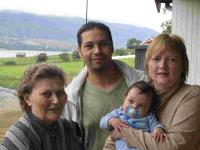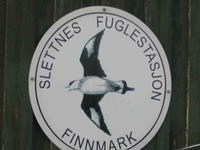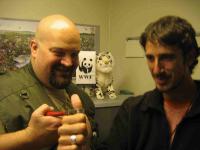



How dou you say “the end of the world” in norwegian. You say that “Finnmark”. Even if the name makes unnecesary any further explanation, let’s say this is norways far North, Europe’s northermost territory. The landscape is barren, with an average winter temperature of under 10 C. In spite of this, a handful of norwegian and sami people strive to earn a living from this nature, the first fishing and the later reindeer herding. In 1944 the retreating nazi army burn everything to avoid the advancing russians to find any kind of shelter. Those refusing to migrate south were shot down. That event is still a stigma: no construction predates the 1950s. In winter people stroll in their snowmobiles (if you don’t hace one you are not in) or practice ski. There’s not much more to do.
In this land I was hitch hiking after the Raibow gathering in Dividalen. To memorize the name of the fiords that the road passes one of my drivers suggested a nemotechnic that he used with his kids: “a-po-la-ta-ba” (Altafjord, Porsangerfjord, Laksefjord, etc). While for the average tourist the series evokes memories of homogenous experiences, I was still to discover the wide range of things I was to live, walking from fiord to fiord, sometimes as much as 15 kms a day, hitch hiking if vehicules passed, as I did my way to Gamvik, a tiny fishing village in the far north of Nordkinnhelvoya penninsula. I was to explore all degrees of fortune from empty cans collecting to whale biff.
Even before reaching Altafjorden I met Gun and Salah (she, norwegian, he algerian). They stopped for me on the road and shortly after we were having dinner in their mother’s house in Nordstraumen. Her family had a long tradition of helping travelers, sometimes ven giving them some job in the farm. So, the dinner was exceptionally sophisticated (better than the half pack of biscuits my dinner would ‘ve consisted of) and included this flat fish whose name in english I ignore, but it doesn’t matter, there is only one fish which is flat… The flat fish had been captured in the same fiord. Gun’s mother silently orchetered all the hospitality from a corner in front of her TV, without speaking a word of english, and she took care of every detail as much as Gun and Salah. Before letting me go, the following morning, they gave me a pack of sandwiches of herring, salmon, flatfish and dry rheindeer meat (delicious). The first driver of the morning donated the beer abd thus I walked happily, probably with the vipest load of food my backpack has ever carried.
I arrived to Alta, main and only city in Finnmark, owner of a square and cheap modernism (again the german’s fault), with a terrible rain that wasn’t gonna let me alone for two days. It wasn’t the ideal weather for camping but the precious snacks I was carrying motivated me. But I didn’t have the chance, a local man I asked where to camp took me to his house, He was engineer in the local power plant. By evening I was drinking brandy with his family + curious neighbours arrived to meet the southern man… I Alta, that unfrequent card of the hitchhikers tarot, the washing machine, arose. (there were socks waiting since Sweden) Also in Alta I got to know trough an e-mail that my pans, forgotten in the Netherlands, were taking by a friend by car to Srajevo, Bosnia, and are waiting for me there….
Oh fortuna, velut luna, status variabilis” is the first verse of Carl Orffs’s Carmina Burana. And in the following days the moon was to change. It didn’t stop raining for a second, temperature dropped and trafic extinguished. On the 28 I arrived laboriously to Porsangerfjord and locked in my tent at 6 Pm, unable to resist the rain for a further minute (and I consider myself Ireland-proof, but that was too much). At least four rheindeers were lying at 50 mts from my tent. On the 29 I reached Lakselv, another town in the same fiord. I was walking all day under the rain with my water bag full of hot water and pressed against my face to keep me warm. (I had to asked for new hot water every 15 minutes). I also collected every empty can I would see (you get 1 kr for each). I camped behind a big wooden pale blue house near the fiord, beautifuol and abbandoned.
On the 30th I arrived to Laksefiord and stayed the afternoon in a sami settlement, helping to organize the rheindeers labels (they were gonna be marked). Sami people keep a semi nomadic life, living in the inner Finnmark in winter and taking their herds to the shores to graze in the summer. They really live up to date and even use helicopters to trace their herds. Some people expect the sami to live as picturesque primitive people and deny them the possibility of progress, so they can be nice thing to look at during holidays….
I thought it would take me a week to reach Gamvik, but then a constelation of nice events happened. I said goodbye to the sami family and started to walk. I had the hope of buying biscuits on the way, but some place that come up on the map are not towns at all, but the product of optimist cartographers. Nothing did I cross in 20 kms and went to tent dinnerless. The following morning I arrived to Lebesby with only one thing in mind: buying food. But it was Sunday, I had forgotten that detail… so I had no choice but to knock doord and ask for bread. The woman in the first house didn’t speak any english and wasn’t very helpful either: she came back with a big piece of forzen bread, rock frozen, bagged and smelling of salmon. Closer to murder than to gratefulness I addressed my fists to the second door. I still didn’t suspect that that rock hard bread was the first move in a hospitality domino effect. Because Pal’s familiy in the second house not only had bread to offer, but also they invited me in for a shower and a nice hot lunch. It was a numerous familiy, and during the year the all lived in Nepal. So also a door was being opened in Katmandu. That was the first miracle of the frozen bread. When I was about to set sails and thumbs to Gamvik they decided to visit some friends of them there, taking me some 100 kms to the place. Their friends lived in Slettnes, 2 kms north of Gamvik, in a WWF Migrating bird ringing station. Their names were Roy and Birgitte and they were ornitologists.
The 5 of us had tea in the compact, observatory looking station, in the middle of a plain which only other construction was the Slettnes lighthouse, the world’s Northernmost lighthouse on the mainland. I was first introduced to the basic aspects of the habitws of some of the 160 bird species that inhabit the area, some of which come from as far as Antarctica. Some other notably come only in the dark winter months, when it seems there’s no life at all. One hour later Roy had decided I should saty in the exclusive guesthouse that operates in the former’s lighthouse keeper’s house. His experience in Middle East more than qualified him to negotiate the price and make it plummet to less than half of the original. He ninvited me and I couldn’t decline the extravagancy of staying in the first class place. The guest house owner was also surprised of my journey, and invited me some extras, as roayal crab, speciality from the region, that I could have never payed myself. Another plate I had the chance to taste, this time invited by Birgitte, was whalebiff. All seemed to be too much. I had only knocked the door for a piece of bread.
During dinner Roy told me a bit abour his life. As a scientist he jas worked in dozen of countries from Yemen to Iran, in each of which he is happy to give me contacts. In top of ornitologist Roy works as a psicologist, and his concept of life as a game is fond to me: “I lived three months of my life throwing dads to take each decision”. That lightness of being didn’t stopped him from pregressing in our mundane material world, fact witnessed by the black Porsche Boxster he insist to drive at 40 km/h in the unpaved roads of Slettnes!!! Duriong the weekend Birgitte took me in the Porsche to visit some friends to Kjollefjord. When we would hop off the Porsche some young lad would rise his thumb to express his admiration for the bolid. How to explain it was all the fault of a piece of frozen bread?
The last night was emotive for me. We were in the station when Roy and Birgitte decided to give me a souvenir: one of the rings used for migratory birds. He took the special plies, my finger, and pressed it gently. In the metal the name of the station and the number BA20016 are engraved. We also know because of the records that 20015 was a cormorant. The situation was like this: I had reached the extreme north of the world, where fisrt I had been given old bread and then somebody had taken me for a bird and had ringed me. I know I haven’t shaved but… do I look like a bird. Or maybe it’s just that people in this area, so unvisited by tourist expect any arriving being to be a bird! Well, personally I don’t know if I deserve the honour of being compared with the ilustrous birds that cross oceans and continents each year,, but the metaphore planned by Roy’s sensibility fills me with pride. Still to be seen how far I can fly.
Hospitality in Finnmark
In Gamvik bus station I had the pleasure to had a rather quick chat with Vegard Valberg, from the town’s museum. According to Vegard, when the first guesthouses opened in Finnmark in the 19th century, locals complained that people should get hospitality for free. It was the beginning of tourism. More info can be found, in norwegian language, en el libro “Nesselkongene” (Knutsen, 1990) about the process of trade dinasties and guesthouses in Northern Norway.

No comments:
Post a Comment